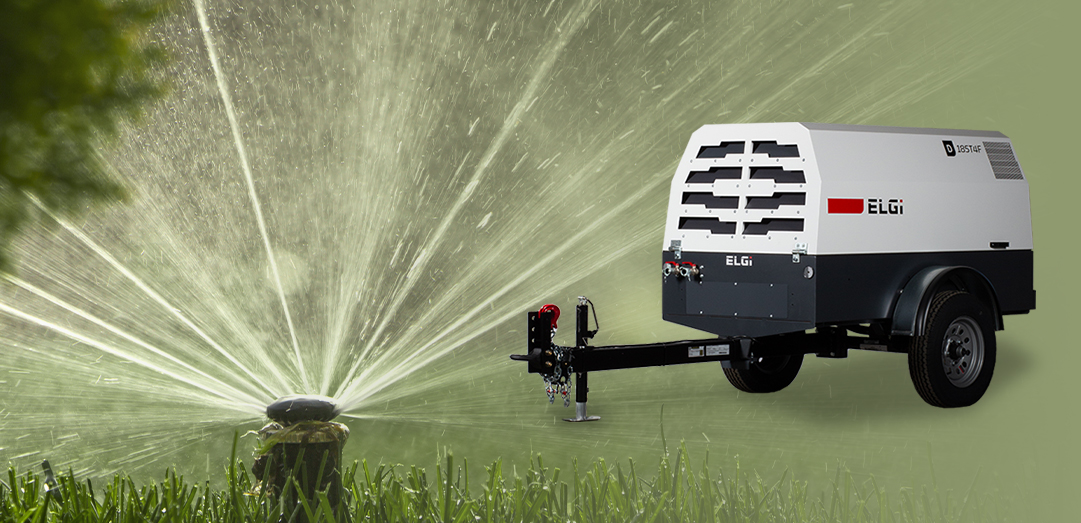How are portable air compressors used to blow out sprinklers during the fall?

Portable air compressors are commonly used to blow out sprinkler systems during the fall, a process known as winterizing or sprinkler blowout. Sprinkler blowout season typically begins in late fall before freezing temperatures set in. Schedule blowouts before the first hard freeze to remove water from pipes, valves, and sprinkler heads, preventing winter damage. Consult local resources for advice on timing based on freeze dates and weather patterns in your area. Here's a step-by-step guide on how portable air compressors are typically used for this purpose:
-
Prepare the compressor: Ensure that the portable air compressor is in good working condition and has enough power to provide sufficient air pressure for the task. Check the compressor's oil level and fuel (if applicable) to ensure they are adequate.
-
Locate the sprinkler system's main shutoff valve: Typically, the main shutoff valve is located near the water source or in the basement or utility room. Shut off the valve to stop the water supply to the sprinkler system.
-
Drain the system: Open all the manual drain valves or bleed valves in the sprinkler system to allow any remaining water to drain out. This helps prevent freezing and damage during winter.
-
Connect the air compressor: Identify the point of connection on the sprinkler system where the air will be introduced. This is usually an access point near the main shutoff valve or on the backflow preventer. Depending on the setup, you may need an adapter or a quick-connect fitting to connect the air compressor hose to the system.
-
Set the pressure: Adjust the pressure regulator on the air compressor to a suitable level for your particular sprinkler system. The recommended pressure is usually between 50 and 80 psi (pounds per square inch), but consult the manufacturer's guidelines or a professional if unsure.
-
Start the compressor: Turn on the air compressor and allow it to build up pressure. Make sure the air compressor is properly grounded and stable during operation.
-
Blow out the sprinkler system: Begin with the zone or section farthest from the air compressor connection point. Open the control valves for that zone and let the compressed air flow through the system. This will force any remaining water out through the open drain valves.
-
Repeat for each zone: Move systematically through each zone, opening the control valves and allowing the compressed air to blow out the water from the pipes, sprinkler heads, and other components. Start with the zones farthest from the compressor and work your way back.
-
Monitor progress: Keep an eye on the pressure gauge on the air compressor. If the pressure drops significantly during the blowout process, it may indicate that there is still water in the system. In such cases, additional time may be needed to fully evacuate the water.
-
Complete the blowout: Once all zones have been blown out, close the control valves and the manual drain valves in the sprinkler system. Disconnect the air compressor from the system.
-
Inspect and protect: Inspect the sprinkler system for any visible signs of damage or leaks. Make any necessary repairs or adjustments before the winter season. Consider covering or insulating exposed components to further protect them from freezing temperatures.
It's important to note that sprinkler blowouts can be a complex task, and it's recommended to consult a professional or someone experienced in sprinkler systems if you're unsure about any step or if you want to ensure the process is done correctly and safely.
What kind of air compressors are used for sprinkler blowout?
Various types of air compressors can be used for sprinkler blowout, depending on the size of the system and the preferences of the user. The most commonly used types of air compressors for this purpose include:
-
Portable Electric Air Compressors: These compressors are compact, lightweight, and operate using electricity. They are suitable for small to medium-sized residential sprinkler systems. Portable electric air compressors typically have a lower air capacity and pressure compared to larger models.
-
Gas-Powered Portable Air Compressors: Gas-powered compressors are typically more powerful and provide higher air pressure compared to electric models. They are ideal for larger residential or commercial sprinkler systems that require higher air volumes. Gas-powered compressors are often more portable compared to larger stationary models.
-
Tow-Behind Air Compressors: Tow-behind compressors are heavy-duty units mounted on a trailer, which can be towed behind a vehicle. These compressors are designed for commercial applications or larger residential properties with extensive sprinkler systems. Tow-behind compressors offer high air capacity, pressure, and extended runtime.
When choosing an air compressor for sprinkler blowout, consider the following factors:
-
Air capacity and pressure: Ensure that the compressor can deliver sufficient air volume and pressure to effectively blow out the system.
-
Power source: Decide whether you prefer an electric or gas-powered compressor based on your specific needs and availability of power sources.
-
Portability: Consider the size, weight, and mobility of the compressor. Smaller systems may require a more portable compressor, while larger systems may necessitate a tow-behind unit.
-
Noise level: Take into account any noise restrictions or considerations, especially if you're operating the compressor in a residential area.
It's important to choose a compressor that matches the requirements of your sprinkler system, as using an underpowered compressor may result in inadequate blowout and potential damage to the system. If you're unsure about the appropriate compressor size or have a complex system, consulting a professional in sprinkler systems or an experienced technician can help you make the right choice.
Are you looking for the right portable air compressor for sprinkler blowout season? Contact our team of professionals at ELGi to help you make your choice.
Get Expert Guidance and Personalized Solutions

